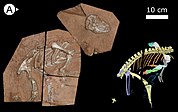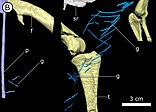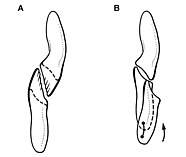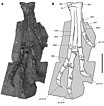Heterodontosaurus
| Heterodontosaurus | |
|---|---|
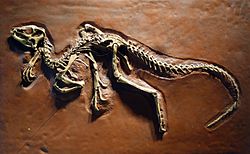
| |
| Cast of specimen SAM-PK-K1332, University of California Museum of Palaeontology
| |
| Scientific classification | |
| Domain: | Eukaryota |
| Kingdom: | Animalia |
| Phylum: | Chordata |
| Clade: | Dinosauria |
| Clade: | †Ornithischia |
| Family: | †Heterodontosauridae |
| Genus: | †Heterodontosaurus Crompton & Charig, 1962 |
| Species: | †H. tucki
|
| Binomial name | |
| †Heterodontosaurus tucki Crompton & Charig, 1962
| |
| Synonyms | |
| |
Heterodontosaurus is a
Though it was a small dinosaur, Heterodontosaurus was one of the largest members of its
Heterodontosaurus is the eponymous and best-known member of the family Heterodontosauridae. This family is considered a
History of discovery
The

In 1966, a second specimen of Heterodontosaurus (SAM-PK-K1332) was discovered at the Voyizane locality, in the Elliot Formation of the Stormberg Group of rock formations, 1,770 m (5,807 ft) above sea level, on Krommespruit Mountain. This specimen included both the skull and skeleton, preserved in articulation (i.e. the bones being preserved in their natural position in relation to each other), with little displacement and distortion of the bones. The postcranial skeleton was briefly described by palaeontologists Albert Santa Luca, Crompton and Charig in 1976. Its forelimb bones had previously been discussed and figured in an article by the palaeontologists Peter Galton and Robert T. Bakker in 1974, as the specimen was considered significant in establishing that Dinosauria was a monophyletic natural group, whereas most scientists at the time, including the scientists who described Heterodontosaurus, thought that the two main orders Saurischia and Ornithischia were not directly related.[5][6] The skeleton was fully described in 1980.[7] SAM-PK-K1332 is the most complete heterodontosaurid skeleton described to date.[8] Though a more detailed description of the skull of Heterodontosaurus was long promised, it remained unpublished upon the death of Charig in 1997.[9] It was not until 2011 that the skull was fully described by the palaeontologist David B. Norman and colleagues.[1]
Other specimens referred to Heterodontosaurus include the front part of a juvenile skull (SAM-PK-K10487), a fragmentary
In 1970, palaeontologist
Description

Heterodontosaurus was a small dinosaur. The most complete skeleton, SAM-PK-K1332, belonged to an animal measuring about 1.18 m (3 ft 10 in) in length. Its weight was variously estimated at 1.8 kg (4.0 lb), 2.59 kg (5.7 lb), and 3.4 kg (7.5 lb) in separate studies.
Following the description of the related
Skull and dentition

The skull of Heterodontosaurus was small but robustly built. The two most complete skulls measured 108 mm (4 in) (holotype specimen SAM-PK-K337) and 121 mm (5 in) (specimen SAM-PK-K1332) in length. The skull was elongated, narrow, and triangular when viewed from the side, with the highest point being the sagittal crest, from where the skull sloped down towards the snout tip. The back of the skull ended in a hook-like shape, which was offset to the quadrate bone. The orbit (eye opening) was large and circular, and a large spur-like bone, the palpebral, protruded backwards into the upper part of the opening. Below the eye socket, the jugal bone gave rise to a sideways projecting boss, or horn-like structure. The jugal bone also formed a "blade" that created a slot together with a flange on the pterygoid bone, for guiding the motion of the lower jaw. Ventrally, the antorbital fossa was bounded by a prominent bony ridge, to which the animal's fleshy cheek would have been attached.[1] It has also been suggested that heterodontosaurs and other basal (or "primitive") orhithischians had lip-like structures like lizards do (based on similarities in their jaws), rather than bridging skin between the upper and lower jaws (such as cheeks).[26] The proportionally large lower temporal fenestra was egg-shaped and tilted back, and located behind the eye opening. The elliptical upper temporal fenestra was visible only looking at the top of the skull. The left and right upper temporal fenestrae were separated by the sagittal crest, which would have provided lateral attachment surfaces for the jaw musculature in the living animal.[1]

The lower jaw tapered towards the front, and the
An unusual feature of the skull was the different-shaped teeth (
The canines had fine serrations along the back edge, but only the lower ones were serrated at the front. Eleven tall and chisel-like cheek-teeth lined each side of the posterior parts of the upper jaw, which were separated from the canines by a large
Postcranial skeleton

The neck consisted of nine
The

The forelimbs were robustly built
The hindlimbs were long, slender, and ended in four toes, the first of which (the
Classification
When it was described in 1962, Heterodontosaurus was classified as a primitive member of Ornithischia, one of the two main orders of Dinosauria (the other being Saurischia). The authors found it most similar to the poorly known genera

By the 1980s, most researchers considered the heterodontosaurids as a distinct family of primitive ornithischian dinosaurs, but with an uncertain position with respect to other groups within the order. By the early 21st century, the prevailing theories were that the family was the
Many genera have been referred to Heterodontosauridae since the family was erected, yet Heterodontosaurus remains the most completely known genus, and has functioned as the primary reference point for the group in the palaeontological literature.[8][3] The cladogram below shows the interrelationships within Heterodontosauridae, and follows the analysis by Sereno, 2012:[35]
| Heterodontosauridae |
| ||||||||||||||||||||||||
Heterodontosaurids persisted from the
In 2017, similarities between the skeletons of Heterodontosaurus and the early
Palaeobiology
Diet and tusk function
Heterodontosaurus is commonly regarded as a
Several more recent studies have raised the possibility that the dinosaur was

In 2012, Sereno pointed out several skull and dentition features that suggest a purely or at least preponderantly herbivorous diet. These include the horny beak and the specialised cheek teeth (suitable for cutting off vegetation), as well as fleshy cheeks which would have helped keeping food within the mouth during
Tooth replacement and aestivation
Much controversy has surrounded the question of whether or not, and to what degree, Heterodontosaurus showed the
A comprehensive analysis conducted in 1980 by Hopson questioned Thulborn's ideas. Hopson showed that the wear facet patterns on the teeth in fact indicate vertical and lateral rather than back and forth jaw movements. Furthermore, Hopson demonstrated variability in the degree of tooth wear, indicating continuous tooth replacement. He did acknowledge that
In 2006, Butler and colleagues conducted
Locomotion, metabolism and breathing
Although most researchers now consider Heterodontosaurus a
Most studies consider dinosaurs as
Dinosaurs likely possessed an air sac system as found in modern birds, which ventilated an immobile lung. Air flow was generated by contraction of the chest, which was allowed by mobile sternal ribs and the presence of gastralia. Extensions of the air sacs also invaded bones, forming excavations and chambers, a condition known as postcranial skeletal pneumaticity. Ornithischians, with the exception of Heterodontosaurus, lacked mobile sternal ribs and gastralia, and all ornithischians (including Heterodontosaurus) lacked postcranial skeletal pneumaticity. Instead, ornithischians had a prominent anterior extension of the pubis, the anterior pubic process (APP), which was absent in other dinosaurs. Based on synchrotron data of a well-preserved Heterodontosaurus specimen (AM 4766), Viktor Radermacher and colleagues, in 2021, argued that the breathing system of ornithischians drastically differed from that of other dinosaurs, and that Heterodontosaurus represents an intermediate stage. According to these authors, ornithischians lost the ability to contract the chest for breathing, and instead relied on a muscle that ventilated the lung directly, which they termed the puberoperitoneal muscle. The APP of the pelvis would have provided the attachment site for this muscle. Heterodontosaurus had an incipient APP, and its gastralia were reduced compared to non-ornithischian dinosaurs, suggesting that the pelvis was already involved in breathing while chest contraction became less important.[13]
Growth and proposed sexual dimorphism

The ontogeny, or the development of the individual from juvenile to adult, is poorly known for Heterodontosaurus, as juvenile specimens are scarce. As shown by the juvenile skull SAM-PK-K10487, the eye sockets became proportionally smaller as the animal grew, and the snout became longer and contained additional teeth. Similar changes have been reported for several other dinosaurs. The morphology of the teeth, however, did not change with age, indicating that the diet of juveniles was the same as that of adults. The length of the juvenile skull was suggested to be 45 mm (2 in). Assuming similar body proportions as adult individuals, the body length of this juvenile would have been 450 mm (18 in). Indeed, the individual probably would have been smaller, since juvenile animals in general show proportionally larger heads.[10]
In 1974, Thulborn suggested that the large tusks of heterodontosaurids represented a secondary sex characteristic. According to this theory, only adult male individuals would have possessed fully developed tusks; the holotype specimen of the related Abrictosaurus, which lacked tusks altogether, would have represented a female.[15] This hypothesis was questioned by palaeontologist Richard Butler and colleagues in 2006, who argued that the juvenile skull SAM-PK-K10487 possessed tusks despite its early developmental state. At this state, secondary sex characteristics are not expected. Furthermore, tusks are present in almost all known Heterodontosaurus skulls; the presence of sexual dimorphism however would suggest a 50:50 ratio between individuals bearing tusks and those lacking tusks. The only exception is the holotype specimen of Abrictosaurus; the lack of tusks in this individual is interpreted as a specialisation of this particular genus.[10]
Palaeoenvironment
Heterodontosaurus is known from fossils found in formations of the
Other dinosaurs from these formations include the genasaur
References
- ^ .
- ^ a b c d e Sereno, P.C. (2012). pp. 114–132.
- ^ a b c d Sereno, P.C. (2012). pp. 4–17.
- ^ S2CID 4198113.
- S2CID 4283187.
- ^ S2CID 4220935.
- ^ OCLC 11886969.
- ^ ISSN 1661-5468.
- S2CID 129586311.
- ^ S2CID 86739244.
- ^ "Dinosaur fossil found in SA finally gives up its secrets". 2016-07-27. Retrieved 2016-07-27.
- ^ "ESRF scans most complete Heterodontosaurus skeleton ever found". www.esrf.eu. 2016. Retrieved 2016-07-27.
- ^ PMID 34225841.
- ^ .
- ^ .
- ^ Charig, A.J.; Crompton, A.W. (1974). "The alleged synonymy of Lycorhinus and Heterodontosaurus". Annals of the South African Museum. 64: 167–189.
- ^ Hopson, J.A. (1975). "On the generic separation of the ornithischian dinosaurs Lycorhinus and Heterodontosaurus from the Stormberg Series (Upper Triassic) of South Africa". South African Journal of Science. 71: 302–305.
- S2CID 53446536.
- ^ S2CID 128636991. Archived from the original(PDF) on 2017-08-11. Retrieved 2015-12-30.
- ISBN 978-1-56458-304-8.
- ^ Sereno, P.C. (2012). pp. 161–162.
- ^ ISBN 978-0-520-06726-4.
- PMID 19846460.
- ^ Pensoft Publishers (2012). "New fanged dwarf dinosaur from southern Africa ate plants". EurekaAlert!. Retrieved January 28, 2016.
- ^ a b Sereno, P.C. (2012). p. 219.
- S2CID 52986589.
- .
- ISBN 978-0-7566-9910-9.
- ISBN 978-0-7853-0443-2.
- ^ Sereno, P.C. (2012). pp. 29–30.
- ISBN 978-0-7167-1822-2.
- ^ Kuhn, O. (1966) Die Reptilien. Verlag Oeben, Krailling near Munich, 154 p.
- .
- PMID 16901832.
- ^ a b Sereno, P.C. (2012). pp. 193–206.
- S2CID 205254710.
- .
- ^ a b c Sereno, P.C. (2012). pp. 162–193.
- ^ ISBN 978-0-521-59449-3.
- ISBN 978-0-375-82419-7.
- ^ PMID 22509242.
- PMID 26692539.
- .
- ^ .
- ISBN 978-0-253-35701-4.
- ^ Maryańska, T.; Osmólska, H. (1985). "On ornithischian phylogeny". Acta Palaeontologica Polonica. 30 (3–4): 137–150.
- ISBN 978-0-295-96570-3.
- ISBN 978-0-520-24209-8.
- PMID 19911059.
- doi:10.2113/176.1.81.
Works cited
- Sereno, P. C. (2012). "Taxonomy, morphology, masticatory function and phylogeny of heterodontosaurid dinosaurs". ZooKeys (226): 1–225. PMID 23166462.
External links
- Natural History Museum: "Big teeth for a tiny dinosaur" – three-minute video about Heterodontosaurus presented by Richard Butler on YouTube
- ESRF Synchrotron: "Digital Heterodontosaurus skeleton produced at the ESRF that shows complete specimen and anatomy" – one-minute video about the synchrotron scan on YouTube

